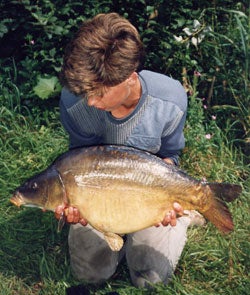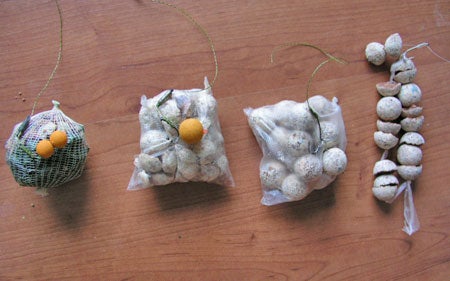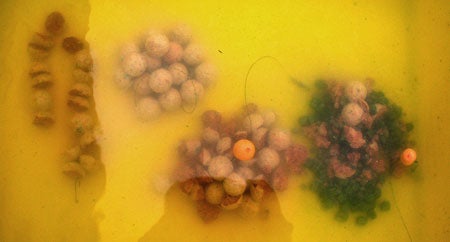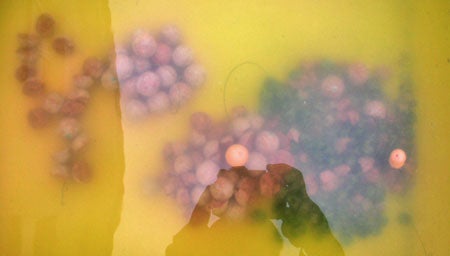PVA…….Tim Paisley once called it the ‘confuser of carp’…..some people think it’s just a way to get a load of bait around the hookbait for the greedy buggers! Why do you use it? How do you use it? Here’s a couple of different ways…..
STRINGERS You can use as many as you like on the stringer but I like to mimic what’s on the hair, ie, if you’re using a snowman rig then group the baits in pairs on the stringer. Sometimes I’ll use a single bait on the hair with doubles on the stringer – the permutations are endless. Another time I use stringers is in heavy rain as they give you a bit more room for error whilst judging the cast. If you want a lot of bait out try the ‘haemorrhoid rig’ where you wrap a stringer containing upwards of 20 baits around the hook. Remember to leave a gap between baits, or the PVA wont dissolve (not necessarily a bad thing?). PVA BAGS The biggest two downsides of bags is that they float if you don’t make enough holes in them, and unless you pack the bag very carefully, they aren’t particularly aerodynamic. That’s why it’s a good idea to have some dry groundbait or micro pellets handy to fill the air gaps in-between the baits. Some people worry about PVA residue around the bait – if you do, just put an old popup or some chum mixer in the bag, they will take the PVA with them as they float to the surface. Also a handy marker to fire baits at… The main time I use bags is when using maggots or micro pellets, or if I want to pour liquid attractors into the bag – something I do a lot in winter. A nice slick of bait dip/minamino/CSL liquid around the hookbait can be a killer method – just try it at home first to make sure it doesn’t melt the bag! PVA STOCKING The thing with these is to use some restraint and not always make massive, apple-sized bags. I find that small £ 2 coin sized (that’s just bigger than a 50p for any northerners who haven’t seen one) balls works better for me – a fish sized mouthful that is likely to tempt ‘browsers’ as well as heavy feeders. (Fair enough, but you southerners are used to small balls…. – Ed) ‘THE METHOD’ Another advantage of the method is that in deep water/summer the bag/stocking could’ve melted before it hits the bottom (unless you ‘double bag’) so the bait gets spread out, and the hooklength can get tangled. You can tell this because the lead will suddenly speed up as it sinks.
To be honest, I rarely use scalded pellets, normally I use a mixture of different pellets, crushed boilies, liquidised particles (great on ‘particle ban’ waters, you can pretend they were in they groundbait….allegedly!) and proprietary groundbait. I keep a big bait bucket in the shed that I just keeping adding the odd bag of groundbait every now and again, along with any stale bread that we have which gets dried out and crushed. I’m just aiming to get lots of different bits and pieces floating around the swim so there’s always something to attract the fish. The first picture shows a stocking with whole/crushed baits and pellets, the second a bag with whole and crushed baits, the third just whole baits, and the fourth a stringer.
On putting them in water, the stocking dissolved pretty much instantly, the bags after 20 seconds or so, but the stringer took about a minute. Not really a problem though. The second is five minutes later and the stringer has dissolved, apart from where the baits were touching, oil is leaking from the pellets and they are starting to spread out, and oil is just starting to leak from the crushed boilies. Half an hour on, not much more change. Pellets have swollen and are starting to dissolve.
The third picture is after four hours. The pellets dissolve if you touch them and the water is quite cloudy. As a side note, I went to take a picture the next morning, but I found only hookbaits! Couldn’t believe it. Cleaned out. There’s some rock hard waters around! The last thing I’ll say is to think about what you use on the hook. No point in filling a bag with tiny particles, pellets, crushed boilies, and then whacking a 20mm bait on the hair. Try and imitate what’s in the bag, so it looks a bit more normal. I’m often not all that sure it makes a difference, as I think a lot of the time the fish just sucks up the whole lot, but it’s a confidence thing. Unless of course you use a high vis pop-up over it. Or a grain of plastic corn. Or a piece of Peperami…… FISHINGmagic Note |
Welcome!Log into your account














